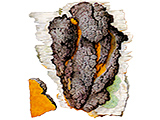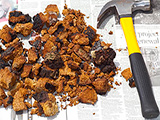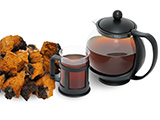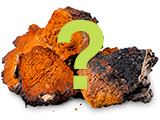According to recent scientific research lending support to a wide range of historical references, certain mushrooms are now touted by many experts to have numerous health benefits including providing anti-aging antioxidants and phytonutrient coumpounds that support a healthy immune system. This botanical family of fungi have powerful nutrients to maintain our health and immunity.
One of the most powerful of all the mushrooms revered for their life enhancing qualities is a rare, precious mushroom called Chaga. With a mystical history, Chaga (Inonotus Obliquus) has been referred to for centuries as the 'King of Herbs". Siberian Chaga contains a unique and potent variety of antioxidants and phytonutrients when compared to other fungi or mushroom (see Fifth Kingdom).
For centuries, Chaga has been revered for its life enhancing properties. Chaga was ingested by the local people of the Siberian mountain regions in tea or powder form, inhaled from smoke, and even applied to the skin for its beneficial properties in promoting good health.
For millennia, Ancient Medical Masters, documented and revered mushrooms as the superior "King of Herbs" for creating "Chi" or life-energy balance, the key to general health and longevity. They often brewed Chaga tea from crushed granules to support good health and for the overall balancing of the body's immune system. Today, Chaga is wildly touted and sought after throughout Asia.
Chaga, is a polypore fungus (Polyporaceae or Gymenochaetaceae family), which grows on birch trees. The fungus produces a black perennial woody growth called a "conk" and is a member of the Basidiomycetes (true mushrooms). Chaga contains an extraordinary amount of phyto-nutrients such as beta glucans, (a unique family of sugars called polysaccharides known to be immune activators), special compounds such as betulinic acid, special pigments including melanins, amino acids and nucleosides.
Because of its irregular shape and the way it is harvested, until now Chaga has generally been sold as dried, cut pieces of varying size. To find high potency Chaga, it can only be harvested in the wild. Many attempts to grow Chaga under commercial harvesting techniques have failed to reproduce the viable potency and quality.
As Chaga becomes known to the Western world, it is now being artificially cultivated and often extracted in alcohol tinctures. The purest and most potent Chaga is not cultivated but rather "wild-crafted", or grown naturally in the wild.
Siberian Chaga, naturally found in the birch forests of the Siberian mountain regions, is the most potent of all the varieties of mushrooms. Chaga is a symbiotic fungus that enters a wound on a mature tree then grows under the bark until it blisters through the bark forming a grotesque black charcoal-like conk on the tree trunk; hence the Latin epithet "Obliquus". The Chaga conk grows with the tree over a 5 to 7 year period, thriving in the harsh Siberian winter environments, absorbing life-sustaining nutrients from the birch tree, until the conk flower fully ripens, falling to the forest floor, followed shortly by the death of the host tree, completing a 20 year micro-ecological cycle.
This superior grade of Chaga is harvested once every 20 years from selective birch trees. Out of 10,000 aged trees, perhaps only 2 or 3 will have Chaga growth. Birch trees make the most acceptable host for the symbiotic relationship between Chaga and birch tree.






